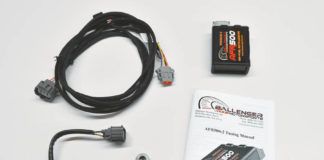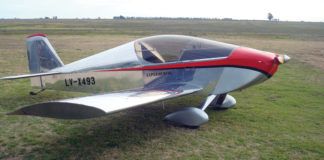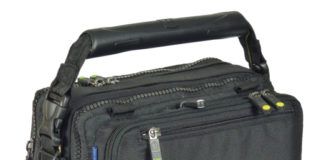Yes, I know that the break-in and fly-off on our RV-10 seemed to take awhile, but allow me to pick up where my last column left off by letting you in on this little known homebuilder secret: If you have anything other than stock equipment on your aircraft (and most homebuilt kits are modified somewhere), then the thorough shakedown flights do take time. Ol Silverback, as I was beginning to call our RV-10, has a different cowling, different main wheelpants, and an Airflow Performance fuel-injection system with an updraft sump using Vans filtered airbox, to name a few of the mods. Wed also had a couple of snafus and setbacks. There was an itinerant voltage regulator, seized bearings in the nosewheel, cranky software and a magnetometer failure-all fixable with new hardware, revised plans and a little more testing. That took us through May of 2008. But at least we were flying.
Now for Paint
As much as we wanted to complete the FAA-mandated 40-hour test-flight fly-off quickly and get down to the fun part of flying our family around, with a south Florida summer in front of us, we were concerned that the beast was unprotected from the horrors of corrosion, and some serious paint was the best prescription we could find.
Now the only thing my husband, the RV-10s builder, hates worse than fiberglass is paint. The solution: shop it out. Wed negotiated with Craig Barnett, owner of Scheme Designers, and hed come up with a wonderful paint scheme for the airplane. The horizontal lines with tapering trim really softened the bulbous cockpit and enhanced the sleek look of the sloping Sam James cowl and 14-inch spinner. Barnett convinced us to paint the spinner, too, to elongate the look of the airplane. There are still a few curved lines, out on the tips of the vertical stabilizer and wings, to keep the aesthetes in the family happy.
It was a couple of months of back and forth figuring out that paint scheme, but we did it while the airplane was under construction so that there would be no pressure. Finding a paint shop in the summer that could take our machine and render the scheme live? That seemed like it was going to be nigh on impossible without at least a four- to six-month waiting period.
Then Joe Dinolfo at Hawkpainting at the Vandenburg Airport in Tampa, Florida, suddenly had an opening. Wed had Dinolfo paint our Cessna 210 years ago, and that proved to be a durable application. We asked him if hed worked with Scheme Designers before, and he said he had. We visited to see what he was doing, and chatted about paint colors. He talked us into a bright white, with a minimum of metallic (just in the trim), so that we could stick to our budget. The scheme was simplified slightly, again thinking cost, and also serviceability. We then struck a deal, and before we knew it, the airplane was at Vandenburg Airport, in pieces.
Dinolfo touched up a few smiley rivets and smoothed a couple of spots where fiberglass and metal abutted, but generally his job was to prime and paint to spec, which he and his crew did. A month and a half later, the airplane was back with us, reassembled and, frankly, as lovely as Id seen it. I have to acquiesce and admit that for this airplane, stripes work.
July passed, and I was sure we were near the end of our fly-off journey. If only it had been that easy. The first post-paint flight I took revealed that somewhere in the paint or reassembly process the airplane had picked up a list to the left. It wasn’t the fuel balance or the dual elevator trimtabs out of alignment. It took six more flights, each after adjusting a flap, an aileron or wingtip, to bring things back to level. By then, the fly-off restrictions were past, and still the airplane didn’t feel ready for a long trip.
Duty Calls
Didnt matter. A trip came along and grabbed us anyway. An illness in the family necessitated a run from our Florida base to Ohio. We balked at the price of airline tickets, and looked at the hangar. Could 9AB do it? Well, not right away. We needed to update the GPS and EFIS software, and then run it in to make sure that it worked. (It did.) Then we needed to add a little carpeting, and tweak the electrics one more time. Door seals needed to be installed to try and trim the noise a little. (That worked.) After years of building and months of testing, it was one week to finish up. Then it was time.
Seven a.m. The girls were tucked in the rear seats, sleepy and ready for the noise and vibration to lull them back into slumber land for the morning trek north. My husband and I began to step up on the wings, right and left, together and…BAM! The tail hit the concrete! We were in total disbelief. Wed weighed things, and balanced out the center of gravity, and after the swearing stopped my husband admitted hed heard from other RV-10 pilots that sometimes, if you have it loaded in back, you might want to put someone in front before the pilot steps up (or load the pilot from the front). How embarrassing! The kids climbed down from the airplane, totally bewildered, and sat on the concrete. We pulled the airplane back into the hangar.
The damage to the tailcone was minimal and quickly repaired. The paint was no longer perfect, but that was only visible to those who inspected closely. Our egos, though bruised, would recover. We carefully reloaded (with me in the right seat first), fired up and rolled to the runway for our first cross-country trip.
And They’re Off!
The initial power application, ground roll and liftoff were exhilarating, and even with the nose trim dialed down an extra notch and the airspeed dialed up to 120 knots to facilitate cooling on the humid August morning, the airplane climbed at 750 feet per minute. It was different from the Phase I test flights. Those were solo in the airplane, and all business. This was proving that the airplane was the dream machine we were hoping it would be, capable of moving the four of us, fast and comfortably, across the country.
We were at 8500 feet in no time, and leveled off to see the airspeed tape spool up to 155 knots indicated. That trued out to nearly 180 knots, and resulted in 170 knots across the ground at 65% cruise power setting, with the mixture 200 rich of peak, and an average fuel burn of 15 gph.
We are still figuring out the plenum cooling, and have not matched the injectors yet. As such, the engine isn’t happy at lean-of-peak mixture settings, which would automatically lower CHTs, and the temps were seeing now are not yet in the range we feel comfortable running. Well get there.
The TruTrak DigiFlight autopilot was a cinch to program, and helped us by keeping our workload down. The Grand Rapids Technologies dual EFIS did not disappoint. In fact, the EFIS, as the flight wore on, became a source of infinite information, and even entertainment. A twist of this knob, a push of that soft-button, and reams of flight details, from logs of where the airplane had already been (dates, places and flight times right there ready for downloading) appeared on the screen. Cool. Another knob twist and button push from the engine page and all kinds of performance information was displayed, including our miles per gallon (around 11 nmpg average; call it almost 13 statute miles per gallon to make the comparison to automobiles more realistic).
It wasn’t long, even with a fuel stop, before we were talking with Indianapolis Approach and beginning our descent into Batavias airport. All in all, the flight took 5 hours, and that included the brief stop for fuel en route. Nine Alpha Bravo was pretty and, even loaded up, proved fast and economical, too.
I had a hard time believing wed averaged 170 knots ground speed in cruise for 5 hours, but the flight home proved the RV could do it with consistency. We were chock to chock (again, with a brief fuel stop) 5 hours en route, burning at an average of 10.8 nmpg at altitudes from 7500 to 9500 msl. Ultimately we put $700 in avgas in the tanks to move our family of four almost 1500 miles round trip, in 10 hours, with four landings/climb-outs included. We could not have done it via the airlines for less money, or in less time, if the trip to and from the airport, with parking, TSA and wait time were included.
Best of all, though, we could not have done it more comfortably. That bulbous cabin? It is roomy inside, with plenty of space for the girls, who have grown to full size, and their pillows, blankets, laptops, books and DVDs. The airflow through the cockpit is excellent in every regime except for taxi, and then it is at least passable.
It takes awhile for a machine to grow on me, and then to steal my affection. Im tough that way, holding judgment until Im confident the airplane can deliver what it promised. There are still plenty of little chores left to do, from finishing the interior to continuing to tweak the avionics, plenum and engine cooling systems. Even so, it sure is a sweetheart.













